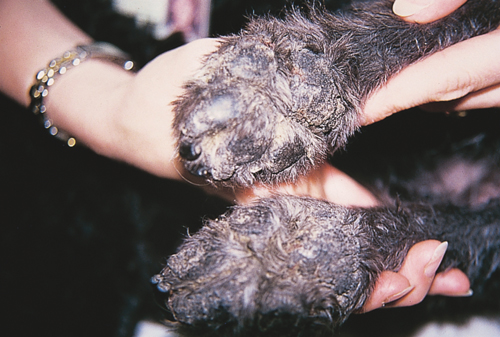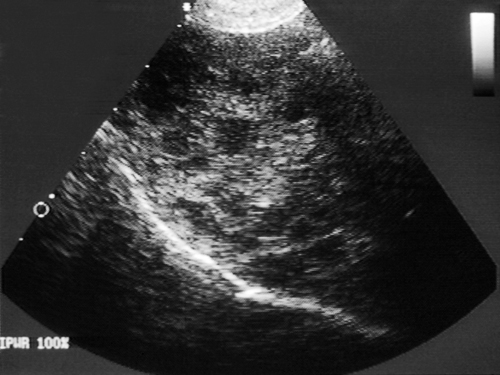Difference between revisions of "Small Animal Abdominal and Metabolic Disorders Q&A 04"
Ggaitskell (talk | contribs) |
|||
| (One intermediate revision by one other user not shown) | |||
| Line 5: | Line 5: | ||
<br> | <br> | ||
[[File:SmAn Ab and Met 04b.jpg|centre|500px]] | [[File:SmAn Ab and Met 04b.jpg|centre|500px]] | ||
| − | |||
| − | |||
<br /> | <br /> | ||
| Line 17: | Line 15: | ||
|a1= | |a1= | ||
The erosive crusting of the nasal planum, oral mucocutaneous junctions, foot pads and genitalia can occur in diseases such as pemphigus foliaceus, drug eruption, lupus erythematosus, necrolytic migratory erythema, zinc-responsive dermatosis and generic dog food dermatoses. | The erosive crusting of the nasal planum, oral mucocutaneous junctions, foot pads and genitalia can occur in diseases such as pemphigus foliaceus, drug eruption, lupus erythematosus, necrolytic migratory erythema, zinc-responsive dermatosis and generic dog food dermatoses. | ||
| − | |l1= | + | |l1= |
|q2=Could there be a connection between the skin lesions and the biochemical and ultrasonographic abnormalities? | |q2=Could there be a connection between the skin lesions and the biochemical and ultrasonographic abnormalities? | ||
|a2= | |a2= | ||
| Line 23: | Line 21: | ||
The ultrasound of the liver demonstrates the patchy appearance of hypoechoic nodules within a hyperechoic background which is characteristic of this disease. | The ultrasound of the liver demonstrates the patchy appearance of hypoechoic nodules within a hyperechoic background which is characteristic of this disease. | ||
| − | |l2= | + | |l2= |
|q3=What further diagnostic tests are indicated? | |q3=What further diagnostic tests are indicated? | ||
|a3= | |a3= | ||
| Line 31: | Line 29: | ||
In humans this syndrome is most often associated with a glucagon-secreting pancreatic tumour. In dogs, glucagonomas have been identified but are very rare. | In humans this syndrome is most often associated with a glucagon-secreting pancreatic tumour. In dogs, glucagonomas have been identified but are very rare. | ||
| − | |l3= | + | |l3= |
|q4=What are the treatment options and prognosis? | |q4=What are the treatment options and prognosis? | ||
|a4= | |a4= | ||
| Line 39: | Line 37: | ||
Unfortunately, the prognosis of affected dogs is poor to guarded. | Unfortunately, the prognosis of affected dogs is poor to guarded. | ||
| − | |l4= | + | |l4= |
</FlashCard> | </FlashCard> | ||
Revision as of 13:18, 26 October 2011
| This question was provided by Manson Publishing as part of the OVAL Project. See more Small Animal Abdominal and Metabolic Disorders Q&A. |
A ten-year-old, entire male Cocker Spaniel presented for evaluation of a progressive, suppurative paronychia of all four feet. Soaking the feet in drying agents decreased the exudation but longterm antibiotic therapy had not elicited an improvement. The foot pads were crusted and cracked and the nail beds were deformed. Crusting, ulcerative lesions on the oral mucocutaneous junctions and scrotum, and hyperkeratosis of the nasal planum were present. Results of initial blood work are shown.
| Question | Answer | Article | |
| What are the differential diagnoses for the skin lesions? | The erosive crusting of the nasal planum, oral mucocutaneous junctions, foot pads and genitalia can occur in diseases such as pemphigus foliaceus, drug eruption, lupus erythematosus, necrolytic migratory erythema, zinc-responsive dermatosis and generic dog food dermatoses. |
[[|Link to Article]] | |
| Could there be a connection between the skin lesions and the biochemical and ultrasonographic abnormalities? | The skin lesions, in conjunction with the abnormal liver parameters, are suggestive of a diagnosis of necrolytic migratory erythema or so-called hepatocutaneous syndrome. The ultrasound of the liver demonstrates the patchy appearance of hypoechoic nodules within a hyperechoic background which is characteristic of this disease. |
[[|Link to Article]] | |
| What further diagnostic tests are indicated? | The diagnosis of hepatocutaneous syndrome is strongly suspected based on the clinical findings so far. A definitive diagnosis may be made with characteristic skin and liver histopathology demonstrating hyperkeratosis and intracellular oedema and periportal vacuolar hepatopathy, respectively. In humans this syndrome is most often associated with a glucagon-secreting pancreatic tumour. In dogs, glucagonomas have been identified but are very rare. |
[[|Link to Article]] | |
| What are the treatment options and prognosis? | A majority of affected dogs have been found to have severe reductions in plasma amino acid concentrations, and the addition of high-protein sources such as egg yolk to the diet has produced considerable improvement in some dogs. Prednisolone has also been shown to improve the cutaneous lesions in some dogs, but approximately 90% of these dogs have abnormal glucose tolerance and hyperglucagonaemia, and the insulin antagonistic effects of steroids may contribute to the development of fulminant diabetes mellitus. Unfortunately, the prognosis of affected dogs is poor to guarded. |
[[|Link to Article]] | |

